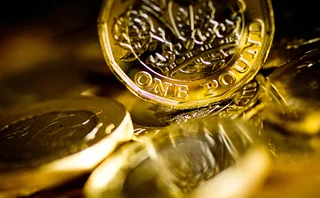
FX Invest: US dollar's time as world's reserve currency draws to a close
The dollar’s demise

Robin Griffiths, technical strategist at Cazenove Capital in London, asks: is the dollar dead?
The lessons of history are that all fiat currencies eventually end up valueless. Politicians normally over promise and under deliver. The superpower of the day always undertakes too much and gets into debt. They it gets out of trouble by trashing the currency they pay back. It was no different for Julius Caesar, or any other superpower since.
So for the concept of the dollar dying, it is not a question of ‘if’ but ‘when’. My answer is “not in my lifetime”. I am reminded that Woody Allen said, on reaching 65, that it came as quite a shock to realise that very nearly half his life was now over. On this basis, the dollar has at least 50 years left to go.
For 200 years, the UK was the dominant superpower and the pound sterling was able to be printed just as Bernanke’s Federal Reserve has printed today’s dollar. It is now half a lifetime since the empire was dismantled and Great Britain is back to being a small island again. However, sterling still exists as a currency and is still rather important. It is just not dominant. This is the fate of the dollar, or rather its destiny.
Under President Dwight Eisenhower, the US economy made up about 60% of the world economy. His dollar really bought something. All economies have grown since then, but now the US is only 24% of the global total. It is likely to be overtaken by China in the next 10 years.
Another 10 years after that, it is probable it will also be overtaken by India. Incidentally, the combined economies of the eurozone are already bigger than the US and contain 550 million people, compared with about 300 million citizens of the US. On a 20-year view, the dollar will go from being the currency of a totally dominant superpower, to that of a number four power. It will still be a large and important currency, and it will still exist.
The Fed was created in 1914 and since then about 94% of the purchasing power of that dollar has already gone. Most of the damage has occurred since 1970. Astonishingly, half of all the dollars that have ever existed have been created since the year 2000. That is when the real downtrend started. It is therefore very much the current Fed policy that is trashing the dollar on the world stage.
It is already a fact, not even a forecast, that for much trade the dollar is no longer the ‘go-to’ currency. When China buys goods from Brazil, they price in real or renminbi. For most trades by China across Asia and particularly with southern hemisphere countries, this is bound to continue and grow.
In the short term, if stock markets go into ‘risk-off’ mode, the dollar will have a significant rally. This move would be likely to retrace half of what the dollar has lost in the past 12 months. Looking at the move against the Canadian dollar, Australian dollar or Swiss franc, this gives scope for a rise of 12% to 15%. In forex markets that is huge. So the dollar might be an aging elephant, but he is still the biggest in the zoo, and is capable of trampling small guys underfoot.
Looking into the future, both the dollar and the euro will survive. The latter might or might not have the Greeks among its members, but will essentially survive as a major currency. Over time, an Asian block will grow, led by the yuan or renminbi. This will also include the Indian rupee.
Although the dollar has already lost its status as the only currency to price world trade, it is still far too soon, by about 20 years, for the Chinese currency to take up the role. We might in fact get an agreed basket of currencies that will include mostly the dollar, euro and renminbi. This basket will also include one element that no government can print, and that will be gold.
Leonardo Castellana, chief investment officer at Palaedino Asset Management in Zurich, says the dollar will ‘melt’
There are numerous reasons why the dollar should collapse, and they are well known by all as so many articles and research papers have dwelt on this subject. However, we are going to focus on why we think it will ‘melt’ – slowly but surely depreciate in value over time – rather than devalue abruptly.
The macroeconomic explanation
Some economists, mainly from the deflationists’ camp, argue that a major drop in the value of the US dollar is needed to restore a new macroeconomic equilibrium.
We went through such a major dollar move during the 1980s. Between the beginning of 1985 and the early 1990s, the dollar fell by almost 50% against a basket of major currencies as measured by the dollar index to bring the US current account deficit back under control.
For the deflationists, we are in a classic liquidity trap. In a post-credit bubble environment like 2008, characterised by excess capacity, a bankrupt financial system and overly indebted consumers, Keynesian responses do not work. Indeed, the increased money supply created by the different rounds of quantitative easing does not reach consumers and personal consumption does not revive. For this reason, demand for US assets decline, inevitably leading to a depreciation of the value of the dollar over time.
Erosion of the dollar supremacy
We live, and have all been living, in a dollar-centric model. However, we think this status is slowly but surely eroding in favour of a new international monetary system. Look at China and Russia for instance. Both countries have decided to use their own currencies for bilateral trade rather than the US dollar.
Until recently, the US dollar had no credible alternatives. Indeed, dollar debt instruments are the most liquid and represent the deepest market in the world; it is a real reserve currency (still representing 60% of today’s foreign reserve of central banks); and it is still the favoured invoicing currency in global trade.
According to a recent report published by the World Bank on May 17, 2010, Multipolarity: the new global economy, the monetary system will move from a dollar-centric reality towards a multi-currency regime. It argued the dollar would lose its status with the emergence of the renminbi and the euro by 2025.
China is moving quickly to internationalise the renminbi. However, we would still need to see full convertibility of its currency before it becomes a realistic alternative to the US dollar. We think we are going there, but the adjustment will not be immediate. This will be done step by step and at the pace dictated by the People’s Bank of China.
For the euro to become an important player in the world balance, European governments need to create an integrated European bond market where the ‘E-bonds’ would jointly be backed by eurozone governments as a group. Comments from European Central Bank governor Jean-Claude Trichet to appoint a European finance minister follow the same underlying rationale. Again, there is still a long way to go but if European governments want the euro to survive and to avoid another Greek-style crisis, this is the only reasonable direction to take.
This power shift away from the dollar will clearly not happen overnight. But with the new debt paradigm that we see arising from the US, investors will be more and more reluctant to blindly accept US bond yield as being the recognised risk-free rate and the dollar as a safe haven. They will look for alternatives, and the renminbi as well as the euro can and should embrace this role.
The new global paradigm
We do not believe we are in the midst of a currency war. We rather think that an orderly dollar depreciation is in everybody’s interest. No-one wants to say it, especially the US government or the Fed, but this is the reality.
This will reduce inflation in emerging countries, where stabilising prices has become the key objective of economic and social policymakers. It will also increase US competitiveness and exports, thereby stimulating output, which is the key objective of US economic policy.
We think an orderly adjustment or a gradual fall of the dollar value across the board will occur. A new economic order is unfolding, with a smooth shift from developed to emerging economies. We should see real economical decoupling and we can assume countries with surpluses would offer greater exchange rate flexibility with their respective currencies to find a new global equilibrium.
As asset managers, we have set up a solution to hedge against this ‘melting dollar’ risk. Because we do not know exactly how fast this scenario will unfold, and because the dollar will not lose its value uniformly against all currencies at the same time, the only way to play this strategically over the long run is to invest passively, but systematically, in the most diversified basket of currencies one can select. Our recently launched Palaedino Hard Currency Index aims precisely at satisfying this objective.
Only users who have a paid subscription or are part of a corporate subscription are able to print or copy content.
To access these options, along with all other subscription benefits, please contact customer services - www.fx-markets.com/static/contact-us, or view our subscription options here: https://subscriptions.fx-markets.com/subscribe
You are currently unable to print this content. Please contact customer services - www.fx-markets.com/static/contact-us to find out more.
You are currently unable to copy this content. Please contact info@fx-markets.com to find out more.
Copyright Infopro Digital Limited. All rights reserved.
As outlined in our terms and conditions, https://www.infopro-digital.com/terms-and-conditions/subscriptions/ (point 2.4), printing is limited to a single copy.
If you would like to purchase additional rights please email info@fx-markets.com
Copyright Infopro Digital Limited. All rights reserved.
You may share this content using our article tools. As outlined in our terms and conditions, https://www.infopro-digital.com/terms-and-conditions/subscriptions/ (clause 2.4), an Authorised User may only make one copy of the materials for their own personal use. You must also comply with the restrictions in clause 2.5.
If you would like to purchase additional rights please email info@fx-markets.com
More on Reserves
Argentina opens IMF talks as crisis deepens
Government extends debt maturity and pledges reserves will not be used to repay international investors
Argentine central bank tries to halt peso’s slide
Peso falls after primary election results come as blow for President Macri
China discloses FX portfolio for first time
Report shows ratio of US dollar-denominated assets declined to 58% in 2014, from 79% in 1995
How Singapore manages its reserves
MAS managing director Ravi Menon explains Singapore’s total approach to reserve management
China’s FX reserves hit seven-month high as capital flows back in
Reserves rise for fifth month in a row in March, as US-China trade thaw eases foreign investors’ concerns
RBI buys $5bn in FX swaps auction
Unusual move to inject long-term liquidity into the system is heavily oversubscribed
Colombia central bank buys $1 billion from Treasury
Aims to support plan to enhance international reserves portfolio
Brexit unlikely to affect sterling’s reserve currency status
No-deal scenario could put major downward pressure on the currency







